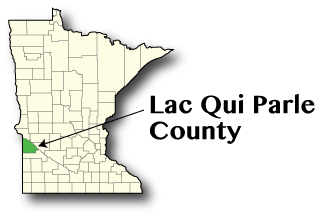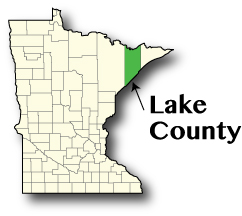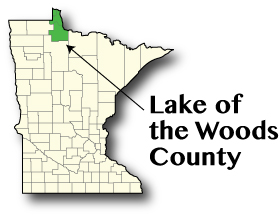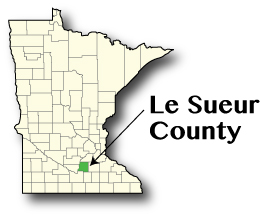by Chet Bodin
January 2018

Lac Qui Parle County was established in 1871 in Southwestern Minnesota. Like most of the state, the county is often identified by water as its northern border is the Minnesota River. The name Lac Qui Parle is French for "lake which talks" – a depiction bestowed by Dakota Indians who were struck by the echoes reverberating among the bluffs where the river widens. In 1886 the county seat was moved from Lac Qui Parle village to Madison to meet the new rail line established there. As part of the transition, a group of 150 men and 40 horse-drawn wagons hauled the county courthouse 15 miles during a harsh November blizzard. More recently Lac Qui Parle was ranked the healthiest county in Minnesota in a study by the Robert Wood Johnson Foundation in 2011.1
In November 2017 Lac Qui Parle was one of several rural Minnesota counties to receive a grant from DEED's Office of Broadband Development. The project, expected to be completed in 2018, is projected to reach 136 unserved households and 15 unserved businesses in the southwestern corner of the county.2
Thanks to its beautiful natural resources and ample opportunities for outdoor recreation, the Accommodation and Food Services industry provides the highest number of jobs in Lac Qui Parle County. Despite a 9.7 percent countywide loss in employment since 2007, Accommodation and Food Services grew by 2.0 percent and raised average annual wages by 34.1 percent to over $35,000 in 2016. The largest employment losses in the county came from the Manufacturing industry, which shed 212 jobs from 2007-2016. Still, the Manufacturing industry paid the highest average annual wages in Lac Qui Parle County in 2016 ($47,929 annually). Educational Services (312 jobs) and Retail Trade (243 jobs) rounded out the top four industries in terms of employment last year.
| 2016 Estimates | Lac qui Parle County | Minnesota |
|---|---|---|
| Population | 6,916 | 5,450,868 |
| Labor Force | 3,628 | 3,026,752 |
| Average Unemployment | 4.3% | 3.8% |
| Median Household Income | $49,210 | $63,217 |
| Cost of Living, Individual | $24,854 | $29,856 |
| Cost of Living, Average Family | $43,698 | $55,200 |
| Source: DEED Local Area Unemployment Statistics, Cost of Living; U.S. Census Bureau, 2016 American Community Survey | ||
| Top Industries of Employment | Total 2016 Employment | Percent Change 2007-2016 | Average Annual Wages | Percent Change 2007-2016 |
|---|---|---|---|---|
| Total, All Industries | 2,207 | -9.7% | $33,132 | 20.4% |
| Accommodation and Food Services | 506 | 2.0% | $35,440 | 34.1% |
| Educational Services | 312 | -3.7% | $34,542 | 3.6% |
| Retail Trade | 243 | -20.8% | $22,159 | -19.0% |
| Manufacturing | 155 | -42.2% | $47,929 | 43.7% |
| Source: DEED Quarterly Census of Employment and Wages 2006-2015 | ||||
1'King Jake,' Norwegian-born Minnesotan, reigned in Lac qui Parle
2Rural broadband grants awarded in Lac Qui Parle and Pope Counties

Lake County was first established as Superior County in 1855, but changed names twice before settling on Lake County in 1856. In 1868 iron ore was discovered on the Vermillion Range, and after considerable work the first shipment of iron ore was made from Agate Bay in 1884. Verging on the county's western border, the Vermillion range averaged over a million tons of iron ore yearly from 1892 through 1952, most of which was shipped through the port at Two Harbors, the county seat. In 1902 five businessmen from Two Harbors established a new mining company named 3M, which today has grown into a Fortune 100 company with over 70,000 employees and 50,000 products.3
Today tourism has replaced mining as the major source of employment in Lake County. The Superior National Forest and the Boundary Waters Canoe Area are both partly in Lake County and attract an estimated 250,000 visitors every year. Canoeing and biking are the main attractions, but rock climbers are starting to converge on the North Shore Adventure Park, which opened in the summer of 2017 and is gaining praise nationwide. In addition to rock climbing, the park is expanding to include a Minnesota-shaped climbing tower and several rope-sporting activities next year.4
In addition to tourism jobs in Accommodation and Food Services, there are over 500 Manufacturing jobs in Lake County, which paid the highest average annual wage in 2016. Manufacturing jobs held steady in Lake County from 2007-2016 despite a 9.2 percent decrease in jobs overall. Another major county industry, Public Administration, also maintained its jobs over the 10 year period. The largest challenge for Lake County will be keeping up despite low labor force participation. At 56 percent in 2016, Lake County had the second lowest labor force participation rate in the state.
| 2016 Estimates | Lake County | Minnesota |
|---|---|---|
| Population | 10,721 | 5,450,868 |
| Labor Force | 5,373 | 3,026,752 |
| Average Unemployment | 6.5% | 3.8% |
| Median Household Income | $52,320 | $63,217 |
| Cost of Living, Individual | $28,723 | $29,856 |
| Cost of Living, Average Family | $51,003 | $55,200 |
| Source: DEED Local Area Unemployment Statistics; Cost of Living; U.S. Census Bureau, 2016 American Community Survey | ||
| Top Industries of Employment | Total 2016 Employment | Percent Change 2007-2016 | Average Annual Wages | Percent Change 2007-2016 |
|---|---|---|---|---|
| Total, All Industries | 3,928 | -9.2% | $39,238 | 19.5% |
| Accommodation and Food Services | 704 | -12.5% | $18,072 | 43.6% |
| Manufacturing | 537 | 0.9% | $59,553 | 23.6% |
| Public Administration | 399 | 0.5% | $43,785 | 22.0% |
| Retail Trade | 340 | -9.6% | $27,812 | 31.1% |
| Source: DEED Quarterly Census of Employment and Wages 2006-2015 | ||||
4North Shore Adventure Park Breaks Ground

Lake of the Woods County separated from Beltrami County and was established in November, 1922. The county owes its name to the 1,679 square mile lake that covers the northern tip of Minnesota. Prior to its official designation, Lake of the Woods was a major link in the voyageur's highway with all of the trade returning from the north and west destined to cross the lake. This throughway became a point of contention in the 1820's as the U.S. and Canada drew borders following the Revolutionary War. Negotiations ended with the U.S. maintaining the Northwest Angle, a relatively small piece of land northwest of the Lake, which juts out from the international border as an easily identifiable trademark of Minnesota geography.5 There were also rumors of gold in the area, but nothing came of them.
In winter of 2017 representatives from both the Fremont - Winema and the Rogue - Siskiyou National Forests met with Lake of the Woods and Fish Lake resorts and others to discuss the development of groomed trails for cross country skiers. In addition to the enthusiastic fishing and hunting activities in the region, the effort looks to bolster even further the tourism industry in Lake of the Woods County.6
Over a quarter of the jobs in Lake of the Woods County are in Accommodation and Food Services, a nod to avid tourism in the county. Like other parts of northern Minnesota, Lake of the Woods County leverages its beautiful natural resources to attract those who enjoy outdoors sports and recreation activities. Overall, employment increased in Lake of the Woods County since 2007, a very positive trend for a rural Minnesota county. But recreation opportunities may not be the only thing attracting outsiders. While average annual wages in Lake of the Woods County grew by almost 20 percent since 2007, the cost of living for the average family remained over $10,000 less than the state average.
| 2016 Estimates | Lake of the Woods County | Minnesota |
|---|---|---|
| Population | 3,901 | 5,450,868 |
| Labor Force | 2,406 | 3,026,752 |
| Average Unemployment | 4.7% | 3.8% |
| Median Household Income | $45,732 | $63,217 |
| Cost of Living, Individual | $25,044 | $29,856 |
| Cost of Living, Average Family | $43,889 | $55,200 |
| Source: DEED Local Area Unemployment Statistics; Cost of Living; U.S. Census Bureau, 2016 American Community Survey | ||
| Top Industries of Employment | Total 2016 Employment | Percent Change 2007-2016 | Average Annual Wages | Percent Change 2007-2016 |
|---|---|---|---|---|
| Total, All Industries | 1,596 | 5.1% | $32,410 | 19.2% |
| Accommodation and Food Services | 440 | 3.5% | $19,490 | 54.3% |
| Retail Trade | 193 | -2.5% | $22,241 | 36.9% |
| Health Care and Social Assistance | 163 | -7.9% | $39,881 | 22.8% |
| Public Administration | 158 | 0.0% | $42,932 | 22.6% |
| Source: DEED Quarterly Census of Employment and Wages 2006-2015 | ||||
5Lake of the Woods Historical Society
6Winter Trail Improvements Discussed at Lake of the Woods

Le Sueur County is named after Pierre Charles Le Sueur, the French explorer who in 1700 traveled up the Minnesota River which makes a major turn just south of the county and subsequently runs northeast along Le Sueur County's western border. Railroad activity flourished in Le Sueur county beginning in 1870 which strengthened the agriculture and livestock industries. Le Sueur County is also known for its history of severe weather, especially tornadoes. Since 1950 Le Sueur County has had 129 tornadoes touch down, an average of two per year. In 1965 an F4 tornado ravaged the county, injuring 175 and causing three deaths.7
Le Sueur County is becoming a state leader in soil and water quality, an important distinction for an agriculture-heavy county with over 1,000 farms. At the tail end of 2017 the Le Sueur County Soil and Water Conservation District received a $387,100 grant from the state of Minnesota for wetland restorations, water and sediment control basins, and grade stabilization projects. The projects aim to improve the quality of water in the Jefferson German chain of lakes.8
Over a third of the jobs in Le Sueur County are in the Manufacturing industry, which has grown by over 42 percent since 2007. Manufacturing, along with Retail Trade (up 23.3 percent) and Healthcare and Social Assistance (up 8.3 percent), have driven growth in Le Sueur County, where overall jobs have increased by over 16 percent since 2007. The recent job growth may be resulting from an improvement in wages in the county. In 2016 the median household income in Le Sueur was just shy of the state median, but the cost of living remained well below that statewide.
| 2016 Estimates | Le Sueur County | Minnesota |
|---|---|---|
| Population | 27,650 | 5,450,868 |
| Labor Force | 15,564 | 3,026,752 |
| Average Unemployment | 4.9% | 3.8% |
| Median Household Income | $62,462 | $63,217 |
| Cost of Living, Individual | $27,950 | $29,856 |
| Cost of Living, Average Family | $49,116 | $55,200 |
| Source: DEED Local Area Unemployment Statistics; Cost of Living; U.S. Census Bureau, 2016 American Community Survey | ||
| Top Industries of Employment | Total 2016 Employment | Percent Change 2007-2016 | Average Annual Wages | Percent Change 2007-2016 |
|---|---|---|---|---|
| Total, All Industries | 9,141 | 16.1% | $39,937 | 36.3% |
| Manufacturing | 3,344 | 42.2% | $50,551 | 39.6% |
| Retail Trade | 842 | 23.3% | $20,011 | 15.6% |
| Health Care and Social Assistance | 702 | 8.3% | $29,939 | 21.9% |
| Educational Services | 672 | 2.8% | $35,175 | 11.4% |
| Source: DEED Quarterly Census of Employment and Wages 2006-2015 | ||||
7HomeFacts